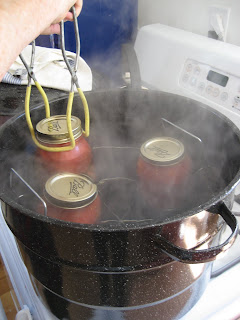Hi All,
I know we haven't done many posts of the Bean, so I thought I'd post a new picture before it's too late. 3 days till the due date!



 Once you are happy with your layout, you then peel the backing off the contact paper stickers and stick them to your surface.
Once you are happy with your layout, you then peel the backing off the contact paper stickers and stick them to your surface.
 You will probably need 2 coats. I did. And here's what the panels look like all painted. As you can see you just paint right over the contact paper shapes.
You will probably need 2 coats. I did. And here's what the panels look like all painted. As you can see you just paint right over the contact paper shapes. Once the paint has dried completely you can peel off your contact paper shapes to reveal the backround coler that has been preserved underneath. It is a little bit of a painstaking process, but the paint didn't peel off in the wrong places, which was a relief.
Once the paint has dried completely you can peel off your contact paper shapes to reveal the backround coler that has been preserved underneath. It is a little bit of a painstaking process, but the paint didn't peel off in the wrong places, which was a relief.
 And that's that. Here is the final product, complete with changing table top (from Land of Nod). It's all ready and just waiting for a Bean!
And that's that. Here is the final product, complete with changing table top (from Land of Nod). It's all ready and just waiting for a Bean!






 Everyone, meet our new wood stove, Otto. We're very pleased and proud with this addition to the family. After a long period of research we decided on Jøtul, a Norwegian company. It's very attractive with its matte black finish and glass front door. The stove came with a spark screen so we can keep the front door open and enjoy the crackly goodness of a roaring fire.
Everyone, meet our new wood stove, Otto. We're very pleased and proud with this addition to the family. After a long period of research we decided on Jøtul, a Norwegian company. It's very attractive with its matte black finish and glass front door. The stove came with a spark screen so we can keep the front door open and enjoy the crackly goodness of a roaring fire.  We also needed to bring in a bunch of wood that we hope will last through the winter, though it seems at some point we'll need to re-up the stash. Here's our lovely stack in the catch all room. There's just over 2 cords of wood here (a cord is defined as enough wood that fits a 4ft x 4ft x 8ft space).
We also needed to bring in a bunch of wood that we hope will last through the winter, though it seems at some point we'll need to re-up the stash. Here's our lovely stack in the catch all room. There's just over 2 cords of wood here (a cord is defined as enough wood that fits a 4ft x 4ft x 8ft space).




